

Welcome to Forbes. What Knight-Mozilla OpenNews has learned about preparing non-journalists for the newsroom. Since 2011, Knight-Mozilla OpenNews has selected 26 coders, developers, and technologists for their competitive fellowship program, which embeds fellows in news organizations for 10-month stints meant to educate both the organization and the individual.

Of those 26 fellows, says editorial lead Erin Kissane, only about seven had previous experience in journalism. Gannett's changes bring excitement, some pain, and a full-time beer beat. Yesterday was a busy one for Joshua Awtry.
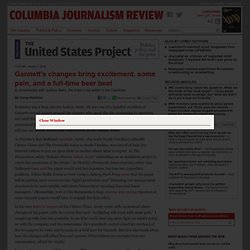
He was one of a handful of editors at Gannett-owned papers around the country who spent the day explaining to reporters and staff the specifics of some big changes coming their way. Gannett, which recently announced it is splitting its publishing and broadcast divisions into separate businesses, will also see several newsrooms restructured in the coming weeks. 'This American Life' blazes risky financial path (Video) - Chicago Business Journal. Subbable: Subscription crowdfunding for rabid YouTube fans. By Carmel DeAmicis On September 30, 2013 Two brothers — Hank and John Green — have produced online videos since 2007.

Known as the VlogBrothers, they gained notoriety for their work on early Web shows such as “Brotherhood 2.0″ and “The Lizzie Bennet Diaries.” They caught Google’s eye and got funded as part of the YouTube Original Channel Initiative. Journalism has become unstuck in time. Bezos And Buffett, Are They Right About Newspapers? At School Papers, the Ink Is Drying Up. Photo The Clinton News used to be the source for everything that mattered to its readers in the northwest Bronx.
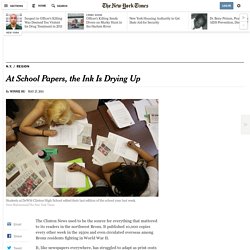
It published 10,000 copies every other week in the 1930s and even circulated overseas among Bronx residents fighting in World War II. It, like newspapers everywhere, has struggled to adapt as print costs soared, and Facebook and Twitter became the media of choice among younger generations. The State of the News Media 2013. In 2012, a continued erosion of news reporting resources converged with growing opportunities for those in politics, government agencies, companies and others to take their messages directly to the public.
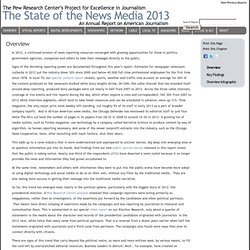
Signs of the shrinking reporting power are documented throughout this year’s report. Estimates for newspaper newsroom cutbacks in 2012 put the industry down 30% since 2000 and below 40,000 full-time professional employees for the first time since 1978. What effect has the internet had on journalism? For Peter Beaumont, this newspaper's foreign affairs editor, the revolution in Egypt revealed more than the power of the people in triumphing over repressive regimes; on a personal level, he discovered something new about his working practices.
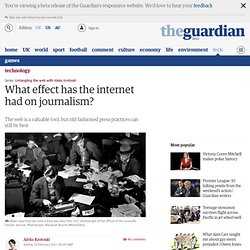
Beaumont trained as a journalist in the days before the world wide web, but, like most of his profession, he has integrated new technologies into his news-gathering techniques as they've emerged. Covering the events in Cairo during the internet blackout in Egypt was like taking a step back in time. "We went back to what we used to do: write up the story on the computer, go to the business centre, print it out and dictate it over the phone," he says.
"We didn't have to worry about what was on the internet; we just had to worry about what we were seeing. Pay Walls Could Be Print's Salvation Online. The ballad of the death of journalism by way of the Internet has been playing for some time.

But print newspapers may be pressing 'pause' with introduction of digital pay walls, as more local dailies follow the New York Times, Wall Street Journal and other national newspapers' lead. According to Newspaper Association of America data, circulation revenue grew by 5 percent for dailies in 2012, making it the first year of circulation growth in a decade, in part due to widespread adoption of digital subscriptions. Publishers are hopeful that digital subscriptions will secure long-term survival as their newspapers meet short-term goals getting readers to pay for content. [READ: Buffett: 'No Thanks' on Buying Tribune Papers] Once upon a pre-Internet time, newspapers were built on the 80-20 model, receiving 80 percent of their revenue from advertising and 20 percent from print subscriptions. After Newsweek, U.S. News Offers Different Model. While the pundits ponder the future of a digital-only Newsweek, U.S.

News & World Report offers a different lesson for magazine publishing. U.S. News went all-digital two years ago as part of a years-long process of deemphasizing print in favor of online rankings at USNews.com of colleges, hospitals and other institutions. Summly, iPhone app disrupting the news. Much of the coverage so far of Nick D'Aloisio has focused on his age.
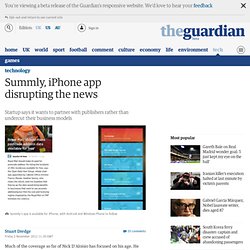
He started writing apps in 2008 when he was 12, and raised the first round of venture capital for his startup Summly three years later. Cue conference appearances and press interviews peppered with questions focusing on the age thing – how did GCSEs fit in, shouldn't he be out at parties, what did his parents think etc. New York Times Gets Another Brick in Its Paywall. New York Times Raising Subscription Price. Newsweek Will Cease Print Publication at End of Year. 9:27 p.m. | Updated From the start, it was an unwieldy melding of two newsrooms: a legacy print magazine, Newsweek, combined with an irreverent digital news site, The Daily Beast.
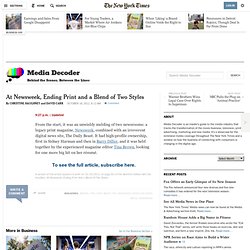
It had high-profile ownership, first in Sidney Harman and then in Barry Diller, and it was held together by the experienced magazine editor Tina Brown, looking for one more big hit on her résumé. But on Thursday, Newsweek buckled under the pressure afflicting the magazine industry in general and newsweeklies in particular, with their outdated print cycles that have been overtaken by the Internet. In a message posted on The Daily Beast, Ms. Brown announced that Newsweek would cease print publication at the end of the year and move to an all-digital format. The staff remaining will publish a digital magazine called Newsweek Global. Ms. But behind the scenes, current and former employees say, there were tensions that led to an increasingly tumultuous newsroom, as financial losses mounted and Ms. The Search for a New Business Model. A new study, which combines detailed proprietary data from individual newspapers with in-depth interviews at more than a dozen major media companies, finds that the search for a new revenue model to revive the newspaper industry is making only halting progress but that some individual newspapers are faring much better than the industry overall and may provide signs of a path forward.
In general, the shift to replace losses in print ad revenue with new digital revenue is taking longer and proving more difficult than executives want and at the current rate most newspapers continue to contract with alarming speed, according to the study by the Pew Research Center’s Project for Excellence in Journalism. Cultural inertia is a major factor. Have Consumers Become More Willing to Pay for Content? - Room for Debate. Will the Internet Save Newspapers? The two visions of higher education’s future I described in my column this week – Stanford Professor Sebastian Thrun’s mission of a virtual university and Stanford President John Hennessy’s devotion to a flesh-and-blood campus – intrigued me because of the larger context.
Checking in with the Newport Daily News: Two years after a digital paywall, print is still king. The Newport (R.I.) Daily News might have been ahead of its time in offering the Frank Rich discount: The newspaper charges a hefty premium for digital-only access in hopes of boosting print subscriptions. For Papers, a Downsizing Trickle Becomes a Flood. Kevin P. Casey for The New York Times In Seattle, boxes holding the city’s two major dailies. On Tuesday, The Post-Intelligencer will produce its last printed edition and become an Internet-only news source. And it is not alone. The Rocky Mountain News shut down two weeks ago, and The Tucson Citizen is expected to fold next week. At least Denver, Seattle and Tucson still have daily papers. Circulation at Globe, Herald suffers sharp decline. The daunting reality facing newspapers.
If chief executives get the big bucks for their ability to put the best face on bad situations, then newspaper bosses really earned their pay this week at the annual UBS media conference in New York. Why newspapers can’t stop the presses. With newspaper ad sales falling at an unexpectedly abrupt rate, many publishers at mid-year were laying off staff, requiring unpaid furloughs, consolidating plants and taking other measures to buttress their bottom lines.
Although some analysts have interpreted these expense-cutting tactics as a repudiation of the print newspaper business by publishing companies, they are anything but. Publishers have undertaken these measures in an effort to keep their traditional businesses as strong as possible to fund the transition to digital publishing.